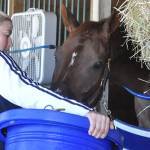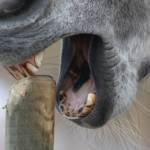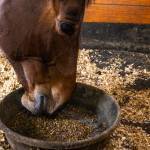How Does a Hindgut Buffer Work in Horses?

Modern feeding practices for performance horses often include large grain meals, a diet that can lead to hindgut acidosis. Buffering the hindgut can be an effective prevention of subclinical acidosis, but delivering the buffer to the affected area has proven difficult.
A study was designed to evaluate the effect of EquiShure, a hindgut buffer developed by Kentucky Equine Research, on blood and hindgut parameters in horses receiving high-grain diets.
Seven fit Thoroughbred geldings were used in a switchback design with periods of four weeks. Horses received unfortified sweet feed, timothy grass hay, and 50 g of loose salt, either with or without 168 g/day of EquiShure. Blood and fecal samples were analyzed for pH. Volatile fatty acids (VFA) were analyzed as an indicator of microbial metabolism in the hindgut.
Horses receiving EquiShure supplementation exhibited VFA patterns that demonstrated the attenuating effects the time-released buffer appears to have on the hindgut environment, thereby minimizing dramatic shifts in pH.
This Kentucky Equine Research study was conducted in 2007 and was presented at the American Association of Equine Practitioners Annual Convention.
Read the entire research paper, titled The Effects of a Time-Released Sodium Bicarbonate Buffer on Exercising Horses Receiving High Concentrate Diets.








